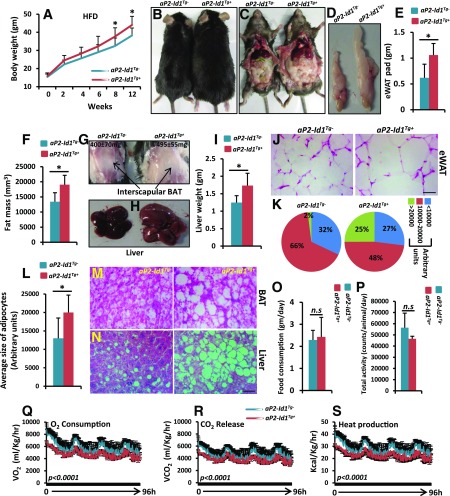Figure 3.
aP2-Id1Tg+ mice are prone to HFD-induced obesity. A: Body weights of HFD-fed male aP2-Id1Tg− and aP2-Id1Tg+ mice (n = 9) at the indicated time points. B–D: Representative photographs of aP2-Id1Tg− and aP2-Id1Tg+ male mice (B), visceral fat (C), and eWAT pads (D) after 12 weeks of HFD. E: Average weight of eWAT pads in aP2-Id1Tg− and aP2-Id1Tg+ mice (n = 6). F: Fat mass density in aP2-Id1Tg− and aP2-Id1Tg+ male mice after 12 weeks of HFD measured by multislice computed tomography scanner (n = 6). G and H: Representative photographs of interscapular BAT (G) and liver (H) of aP2-Id1Tg− and aP2-Id1Tg+ male mice. BAT weight is significantly higher in HFD-fed aP2-Id1Tg+ mice than in aP2-Id1Tg− mice as a result of higher lipid accumulation (n = 6). I: Average liver weight in aP2-Id1Tg− and aP2-Id1Tg+ mice after 12 weeks of HFD (n = 6). J–L: Representative hematoxylin-eosin–stained eWAT sections (J), adipocyte size distribution (K), and the average size of adipocytes (L) in the eWAT of HFD-fed aP2-Id1Tg− and aP2-Id1Tg+ male mice (n = 6). M and N: Representative hematoxylin-eosin–stained BAT and liver sections of HFD-fed aP2-Id1Tg− and aP2-Id1Tg+ male mice. O–S: Food consumption (O), physical activity (P), VO2 rate (Q), VCO2 (R), and heat production (S) in HFD-fed (12 weeks) aP2-Id1Tg− and aP2-Id1Tg+ male mice measured for 4 days by using Oxymax/CLAMS (n = 5). Data are mean ± SD. Scale bars = 10 μm. *P < 0.05. n.s, not significant.

